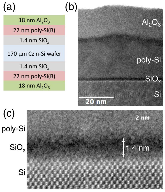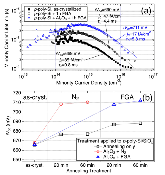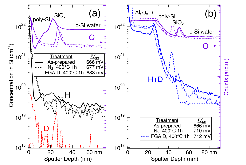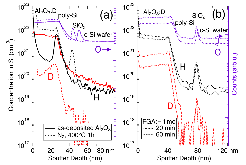Hydrogen passivation of poly-Si/SiOx contacts for Si solar cells using Al2O3 studied with deuterium
- National Renewable Energy Lab. (NREL), Golden, CO (United States)
- Eindhoven Univ. of Technology, Eindhoven (The Netherlands)
Here, the interplay between hydrogenation and passivation of poly-Si/SiOx contacts to n-type Si wafers is studied using atomic layer deposited Al2O3 and anneals in forming gas and nitrogen. The poly-Si/SiOx stacks are prepared by thermal oxidation followed by thermal crystallization of a-Si:H films deposited by plasma-enhanced chemical vapor deposition. Implied open-circuit voltages as high as 710 mV are achieved for p-type poly-Si/SiOx contacts to n-type Si after hydrogenation. Correlating minority carrier lifetime data and secondary ion mass spectrometry profiles reveals that the main benefit of Al2O3 is derived from its role as a hydrogen source for chemically passivating defects at SiOx; Al2O3 layers are found to hydrogenate poly-Si/SiOx much better than a forming gas anneal. By labelling Al2O3 and the subsequent anneal with different hydrogen isotopes, it is found that Al2O3 exchanges most of its hydrogen with the ambient upon annealing at 400 °C for 1 h even though there is no significant net change in its total hydrogen content.
- Research Organization:
- National Renewable Energy Laboratory (NREL), Golden, CO (United States)
- Sponsoring Organization:
- USDOE Office of Energy Efficiency and Renewable Energy (EERE), Solar Energy Technologies Office (EE-4S)
- Grant/Contract Number:
- AC36-08GO28308
- OSTI ID:
- 1440399
- Report Number(s):
- NREL/JA--5900-71231
- Journal Information:
- Applied Physics Letters, Journal Name: Applied Physics Letters Journal Issue: 20 Vol. 112; ISSN 0003-6951
- Publisher:
- American Institute of Physics (AIP)Copyright Statement
- Country of Publication:
- United States
- Language:
- English
Similar Records
On the hydrogenation of Poly-Si passivating contacts by Al2O3 and SiNx thin films
Hydrogen Stability and Bonding in SiNx and Al2O3 Dielectric Stacks on Poly-Si/SiOx Passivating Contacts



